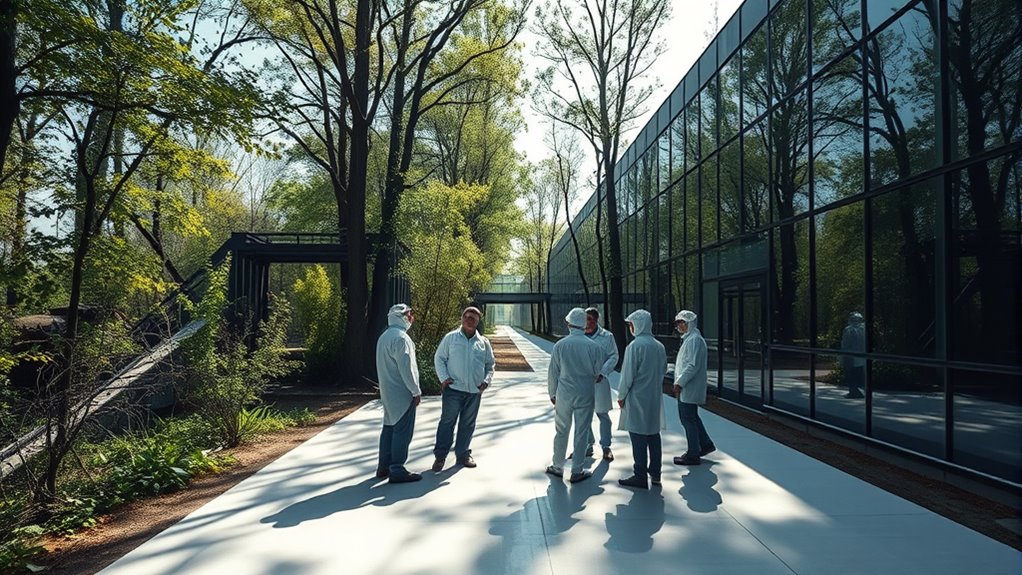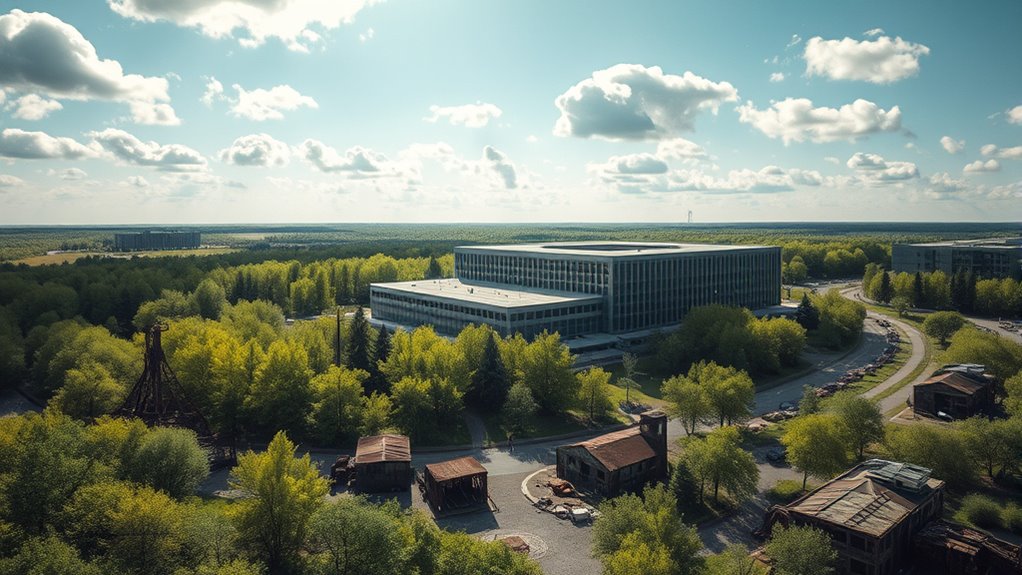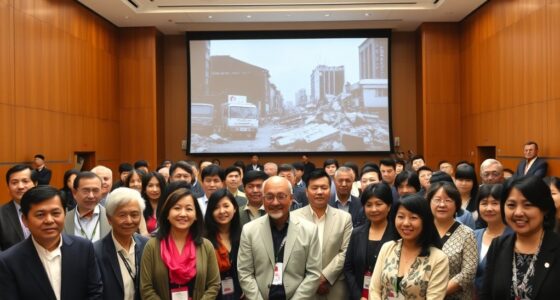The Chernobyl Research Center is set to open in 2025, focusing on the long-term effects of radiation and innovative cleanup technologies within the Exclusion Zone’s unique ecosystem. This groundbreaking facility will enhance our understanding of radiation’s impact on health and the environment, leveraging the area’s remote setting for essential studies. With ongoing security challenges and community involvement, the center aims to foster international collaboration. Stay tuned for more details on this exciting development and its potential implications.
Key Takeaways
- The new research center aims to enhance studies on long-term radiation effects on health and the environment in the Chernobyl Exclusion Zone.
- Improved infrastructure and the New Safe Confinement structure will facilitate safer research operations and handling of hazardous materials.
- The center will promote international collaboration among experts in various fields to address the challenges of radiation exposure and ecosystem health.
- Ongoing security measures are crucial to ensure safe research activities amid recent incidents, such as drone attacks in the area.
- Local communities will be involved in research and management, emphasizing the importance of public health policies based on scientific findings.

As the Chernobyl Research Center officially opens its doors, it promises to reveal essential insights into the long-term effects of radiation on both human health and the environment. This initiative, funded through international collaborations, highlights the joint efforts of governments like the U.S. and Ukraine to understand and manage the aftermath of the 1986 disaster.
With a specific focus on genetic mutations, radionuclide movement, and innovative cleanup technologies, this research center is set to become a beacon of scientific inquiry.
The 30-kilometer exclusion zone surrounding Chernobyl serves as a unique ecological laboratory, allowing researchers to study the profound effects of radiation in an environment largely free from human interference. The site’s infrastructure has greatly improved since the accident, with the New Safe Confinement constructed in late 2018 to securely contain the damaged reactor.
This advancement enables remote handling of hazardous materials, ensuring safety for researchers working in potentially dangerous conditions.
While the site is well-equipped with various research facilities and advanced technologies, it faces ongoing security challenges. Recent incidents, including drone attacks, have raised concerns about stability and safety.
Despite these issues, the commitment to studying the environmental impacts of radiation remains unwavering. The research will focus on radiation exposure, groundwater contamination, and the long-term effects that continue to unfold.
One of the center’s primary research priorities is evaluating the health effects of radiation exposure among affected populations. By conducting thorough epidemiological studies, researchers aim to gather essential data that can inform public health policies and improve safety protocols.
Additionally, analyzing genetic mutations in local wildlife offers a glimpse into how radiation alters biological processes over time, providing further evidence of its impact on ecosystems.
The Chernobyl Research Center isn’t just a local endeavor; it embodies a collective international effort. Experts from various fields contribute their knowledge and skills, while organizations like the International Atomic Energy Agency (IAEA) closely monitor and report on site conditions.
The local community, although greatly impacted by the disaster, plays a fundamental role in this ongoing research and its management.
Frequently Asked Questions
Will Visitors Be Allowed at the New Research Center?
As you consider the possibility of visiting a new research center at Chernobyl, it’s essential to stay informed about the ongoing conflict in the region.
Currently, access is restricted due to safety concerns and the war. If the situation improves and the site reopens, you may have the chance to visit.
Until then, keep an eye on updates regarding visitor policies and any developments related to research activities at this historic site.
What Types of Research Will Be Conducted at the Center?
At the new research center, you’ll find a variety of studies focusing on radionuclide movement, groundwater contamination, and soil pollution.
Researchers will analyze airborne radioactivity and assess ecological impacts on local ecosystems.
Wildlife studies will explore genetic mutations, species adaptation, and population dynamics in the area.
Additionally, you’ll see efforts aimed at developing cleanup technologies, waste management solutions, and nuclear safety measures, fostering international collaboration and knowledge sharing among scientists.
How Will the Center Contribute to Nuclear Safety?
Like a lighthouse guiding ships through treacherous waters, the new research center will bolster nuclear safety by advancing technologies and methodologies.
You’ll witness cutting-edge monitoring systems being developed, enhancing real-time responses to potential hazards.
The center will also facilitate international collaboration, allowing for shared insights into risk assessment and mitigation strategies.
What Measures Are in Place to Ensure Visitor Safety?
To guarantee your safety while visiting, guided tours are mandatory, and you’ll receive dosimeters to monitor radiation exposure.
Certain areas are off-limits due to high radiation levels, and you’ll encounter multiple checkpoints requiring identification.
Your tour guide will provide safety briefings, and you’ll need to follow their instructions closely.
Eating and drinking within the zone is discouraged to minimize risks, and emergency protocols are in place should anything unexpected occur.
Is There a Planned Timeline for Future Developments at Chernobyl?
Yes, there’s a planned timeline for future developments at Chernobyl.
You’ll see efforts to remove unstable parts of the original sarcophagus, allowing closer access to the reactor’s interior. As research into health effects and radiation exposure intensifies, collaboration among international experts will be essential.
Additionally, the site aims to transform into a hub for environmental studies and renewable energy projects, making it a significant focus for ongoing scientific advancements and economic revitalization.
Conclusion
As the Chernobyl Research Center opens its doors in 2025, it symbolizes hope and resilience in the face of tragedy. Did you know that nearly 600,000 people were involved in the cleanup efforts after the disaster? Each of them faced unimaginable risks, and their sacrifices paved the way for this new chapter in research and understanding. By studying this site, we honor their legacy and work toward a safer future for all, reminding ourselves of the lessons learned.










